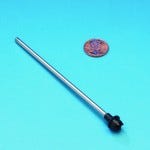Veridiam Turns to Spin Welding to Reduce Lead Time
April 1, 2009

veridiam_spinweld
Veridiam Medical now offers spin welding, a technology that uses rotational friction to precisely weld plastic and metal components together for medical device applications.
To reduce lead time and cost, Veridiam Medical (San Diego) has incorporated spin welding capabilities into its contract manufacturing operations. Using a spin welder, the company can permanently and cleanly attach plastic components to metal assemblies used in medical devices. Having this welding capability allows the company to manufacture and integrate complex components in-house, which can mean faster turnaround and fewer stops along the supply chain for customers.The company purchased the equipment to make better use of its experience in providing machined parts and tubular components specifically designed for medical device OEMs. Prior to gaining the spin-welding capability, the company would construct complex metal components and then outsource them to other vendors to assemble the plastic portion. Plastics vendors that are unfamiliar with medical device development may include unnecessary features in their parts, according to Veridiam. The contract manufacturer hopes to prevent this problem by offering the additional assembly capabilities now possible with the spin welder."We are trying to reach as far down the supply chain as we can," says Dave Ibanez, project manager. "We can now offer higher-quality finished products in less time because we are handling the entire project."Spin welders offer precise control and application for plastic-to-metal welding requirements. The technology relies on rotational friction to produce enough heat to melt the plastic and metal parts together in a highly localized area. Holding the metal object stationary, the machine rotates the plastic part at a high speed and applies pressure. The resulting friction welds the components together to create permanent joints and hermetic seals. In addition to providing efficient part assembly, spin welders have a low rate of power consumption. They also do not produce fumes, emissions, or consumables, according to the company.
You May Also Like

.png?width=300&auto=webp&quality=80&disable=upscale)
